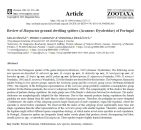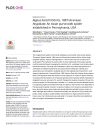Revision of the Peruvian tarantula Homoeomma peruvianum (Chamberlin, 1916): description of a new genus with eleven new species and insights to the evolution of montane tarantulas (Araneae: Theraphosidae: Theraphosinae) 2023
- Authors
- RNDr. Milan Řezáč, Ph.D., Radan Kaderka, Veronika Řezáčová
- Abstract
The Peruvian tarantula Homoeomma peruvianum (Chamberlin, 1916) is revised. As the type specimens do not fit the diagnostic characters of Homoeomma Ausserer, 1871, especially because of the different palpal bulb morphology in males and the shape of spermathecae in females, H. peruvianum (Chamberlin, 1916) was transferred into the newly established genus Urupelma gen. n., which is herein described, diagnosed and illustrated. Eleven new species of Urupelma gen. n. (U. sanctitheresae sp. n., U. sanctimariae sp. n., U. awanqay sp. n., U. ashaninka sp. n., U. atarraz sp. n., U. megantonianum sp. n., U. machiguenga sp. n., U. pampas sp. n., U. johannae sp. n., U. veronicae sp. n., and U. dianae sp. n.) are herein described, diagnosed and illustrated. The monophyly of Urupelma gen. n. is supported by a molecular phylogenetic analysis focused on the tarantulas with urticating setae of type III and III+IV and based on three genes: the nuclear 18S and 28S, and the mitochondrial COI gene. Apart from the support of the new genus and some existing valid genera, the molecular phylogeny also sheds light on the dynamic evolutionary history behind the adaption to high montane environments in tarantulas.
Review of Harpactea ground-dwelling spiders (Araneae: Dysderidae) of Portugal 2023
- Authors
- RNDr. Milan Řezáč, Ph.D., Veronika Řezáčová
Food provisioning to Pardosa spiders decreases the levels of tissue-resident endosymbiotic bacteria 2023
- Authors
- RNDr. Milan Řezáč, Ph.D., Nela Gloríková, Veronika Řezáčová
- Abstract
The diversity, host specificity, and physiological effects of endosymbiotic bacteria in spiders (Araneae) are poorly characterized. We used 16S rDNA sequencing to evaluate endosymbionts in the cephalothorax and legs of a wolf spider Pardosa agrestis. We tested the effects of feeding once or twice daily with fruit flies, aphids, or starved and compared them to those of syntopically occurring Pardosa palustris. The feeding increased traveled distance up to five times in some of the groups provisioned with food relative to the starved control. The Shannon diversity t-test revealed significant differences between these component communities of the two spider species. The increased frequency of feeding with fruit flies, but not aphids, increased the dominance and decreased the alpha diversity of OTUs. The obligate or facultative endosymbionts were present in all analyzed spider individuals and were represented mostly by Rickettsiella, Rhabdochlamydia, Spiroplasma, and the facultative intracellular parasite Legionella. Vertically transmitted endosymbionts were less common, represented by Wolbachia pipientis and Rickettsia sp. H820. The relative abundance of Mycoplasma spp. was negatively correlated with provisioned or killed aphids. In conclusion, the tissues of Pardosa spiders host tremendously diverse assemblages of bacteria, including obligate or facultative endosymbionts, with yet unknown phenotypic effects.
Diet affects the growth and behavior of Argiope bruennichi spiders and correlates with the species richness of their vertically and horizontally transmitted tissue-resident bacteria 2023
- Authors
- Ivana Nagyová, RNDr. Milan Řezáč, Ph.D., Nela Gloríková, Veronika Řezáčová
- Abstract
The ability to spread and build quality webs is crucial to spider survival. These abilities may differ in response to dietary adjustments and changes in assemblages of tissue-resident bacteria, including vertically transmitted endosymbiotic taxa, particularly when expanding outside the native ranges. We measured the physical and behavioral parameters of the invasive wasp spider Argiope bruennichi subjected to four types of diets, including protein-rich and lipid-rich diets. We used 16S rDNA sequencing to evaluate vertically and horizontally transmitted tissue-resident bacteria, including endosymbionts, in the cephalothorax and legs of the tested spiders. The diet composition affected the body weight and carapace length as well as the locomotor parameters but not the orb-weaving abilities. Dietary treatments led to changes in the diversity and operational taxonomic unit (OTU) richness of facultative and obligate tissue endosymbionts, with Wolbachia and Rickettsia having higher relative abundance in spiders fed a lipid-rich diet. The higher OTU richness of facultative and obligate endosymbionts was associated with better locomotor performance. The other tissue-resident microbes were dominated by Firmicutes; the dominance and diversity of tissue-resident microbiomes also differed among spiders treated with different diets. The highest alpha diversity of tissue-resident microbes was present in spiders fed the standard diet, whereas all other diets led to a decrease in alpha diversity and various changes at the level of individual genera and OTUs. In conclusion, the tissues of A. bruennichi host tremendously diverse assemblages of bacteria, including obligate or facultative endosymbionts, which are sensitive to differences in diet composition and affect the locomotion of their hosts.
Atypus karschi Dönitz, 1887 (Araneae: Atypidae): An Asian purse-web spider established in Pennsylvania, USA. 2022
- Authors
- doc. RNDr. Jiří Král, Dr., Mgr. Martin Forman, RNDr. Milan Řezáč, Ph.D., Nela Gloríková, Veronika Řezáčová
- Abstract
The mygalomorph spiders of the family Atypidae are among the most archaic spiders. The genus Atypus Latreille, 1804 occurs in Eurasia and northern Africa, with a single enigmatic species, Atypus snetsingeri Sarno, 1973, known only from a small area in southeastern Pennsylvania in eastern USA. A close relationship to European species could be assumed based on geographic proximity, but A. snetsingeri more closely resembled Asian species. This study was undertaken to learn more about the genetics of A. snetsingeri, its habitat requirements and natural history. Molecular markers (CO1 sequences) were compared to available data for other atypids and showed that A. snetsingeri is identical with A. karschi Dönitz, 1887 native to East Asia. Natural history parameters in Pennsylvania were also similar in every respect to A. karschi in Japan, therefore, we propose that the spider is an introduced species and the specific epithet snetsingeri is relegated to a junior synonym of A. karschi. Cytogenetic analysis showed an X0 sex chromosome system (42 chromosomes in females, 41 in males) and we also detected nucleolus organizing regions and heterochromatin, the latter for the first time in the Atypoidea. In Pennsylvania the spider is found in a variety of habitats, from forests to suburban shrubbery, where the above-ground webs are usually attached vertically to trees, shrubs, or walls, although other webs are oriented horizontally near the ground. Prey include millipedes, snails, woodlice, carabid beetles and earthworms. Atypus karschi is the first known case of an introduced purse-web spider. It is rarely noticed but well-established within its range in southeastern Pennsylvania.
Evolutionary insights into the eco-phenotypic diversification of Dysdera spiders in the Canary Islands 2021
- Authors
- RNDr. Milan Řezáč, Ph.D., prof. Mgr. Stanislav Pekár, Ph.D., Veronika Řezáčová
- Abstract
- The spiders of the genus Dysdera are renowned for including woodlouse specialists. In the Canary Islands, Dysdera underwent remarkable local diversification, and 48 endemic species have been reported to date. We aim to disentangle the evolutionary history underpinning this diversity, with particular emphasis on the evolution of the trophic ecology. We collected specimens belonging to 17 Dysdera species along with the co-occurring potential prey. We performed prey capture experiments with these specimens to assess which species accepted woodlice as prey and how they captured them and used statistical extrapolation and published phylogenetic information to infer the evolution of these dietary and behavioral traits. We identified four capture tactics and trait reconstruction analyses that inferred oniscophagy as the ancestral state. We found several instances of polyphagy that evolved from trophic specialist ancestors. When including the trophic strategy, predatory behavior, body size, and habitat type, it was revealed that at all sites, the co-occurring Dysdera species differed by at least one trait, suggesting the role of adaptive radiation via character displacement. We hypothesize that the colonization of the newly emerged islands by the Dysdera species was probably followed by the recurrent evolution of both woodlice specialists and non-oniscophagous species. The radiation of Dysdera in the Canary Islands indicates that diet specialization can evolve to polyphagy.








